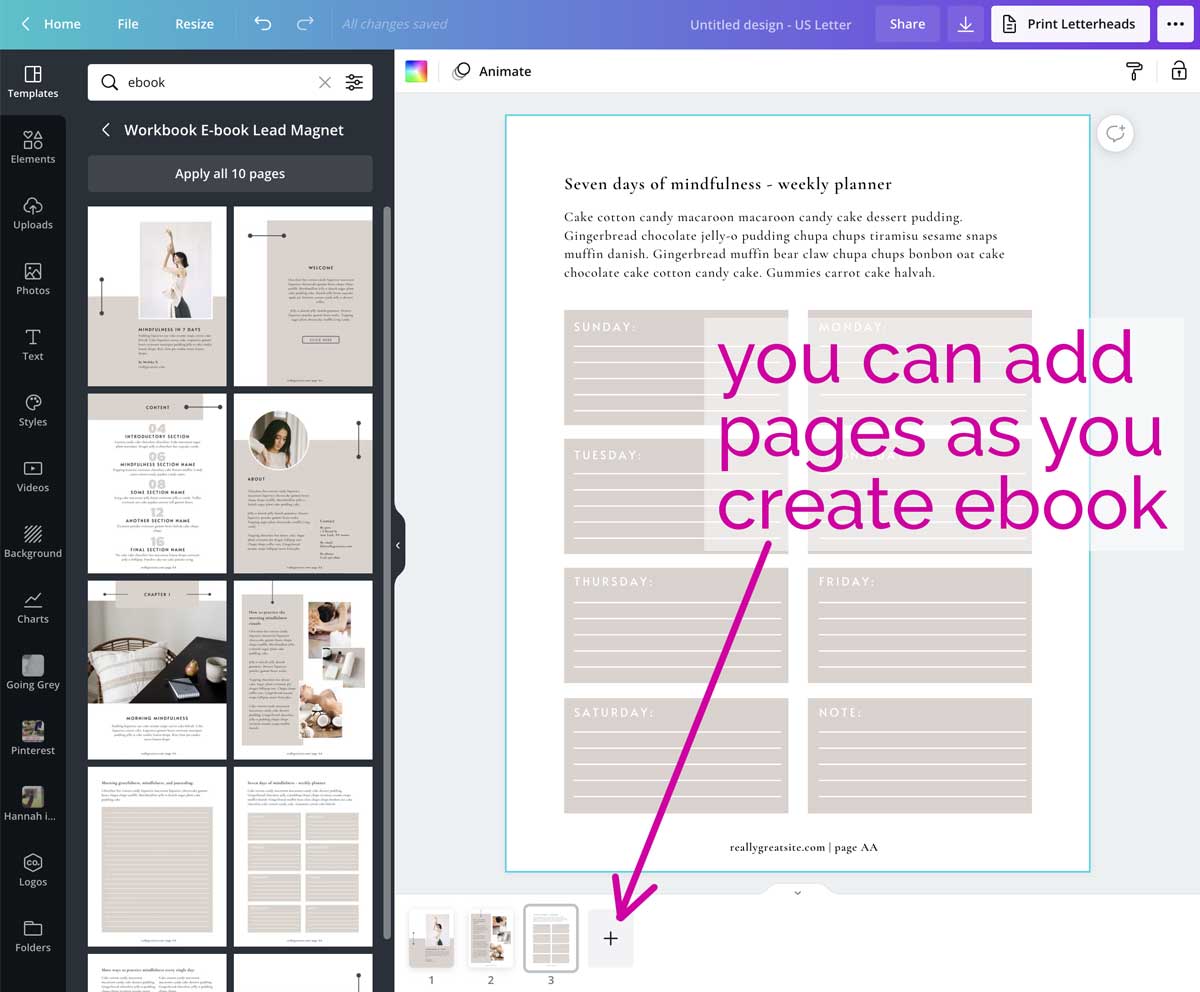Introduction
Welcome to the world of eBook creation! If you have ever dreamed of sharing your knowledge, passion, or expertise with others, creating your own eBook is an excellent way to do it. In this digital age, eBooks have become increasingly popular, providing a convenient and accessible platform for writers to reach their audience.
Whether you are an aspiring author or a seasoned writer, this guide will take you through the process of creating your own eBook. From choosing a topic to publishing and promoting, we’ll cover every step in detail to ensure your eBook is a success.
While the thought of creating an eBook may seem daunting, fear not! With the right tools, resources, and a dash of creativity, you can bring your ideas to life and share them with the world. So, let’s dive in and discover how you can create your very own eBook.
Before we get started, it’s important to note that an eBook is a digital version of a book that can be read on electronic devices such as e-readers, tablets, or smartphones. Unlike traditional print books, eBooks offer the flexibility of being easily distributed and accessed by readers worldwide.
Creating an eBook allows you to leverage the power of technology to reach a wider audience and showcase your writing skills. Whether you want to publish a novel, a guidebook, a how-to manual, or even a collection of short stories, the possibilities are endless.
So, are you ready to embark on this exciting journey of eBook creation? Let’s move on to the first step: choosing a topic for your eBook.
Choosing a Topic for Your eBook
When it comes to creating an eBook, selecting the right topic is crucial. Your chosen topic should be something that you are knowledgeable and passionate about, as this will significantly impact your writing process and the overall quality of your eBook.
Consider your areas of expertise, hobbies, or interests. What subject matter excites you? What are you most knowledgeable about? Brainstorming ideas and conducting research can help you narrow down your options and find a topic that resonates with you.
It’s also essential to consider your target audience. Who are you writing for? Identifying your target audience will help you tailor your content and ensure that it meets their needs and interests.
Additionally, it’s a good idea to conduct market research to assess the demand for your chosen topic. Look for similar eBooks in your niche and evaluate their popularity and reviews. This will give you insights into what is already available in the market, allowing you to identify unique angles or gaps that you can fill with your eBook.
Remember, while it’s important to choose a topic that has market potential, it’s equally important to select a subject that you are passionate about. Writing an eBook takes time and effort, and your enthusiasm for the topic will shine through in your writing, engaging readers and keeping them hooked.
Once you have a list of potential topics, evaluate each one based on its appeal, market potential, and your personal interest. Narrow down your options until you have identified the perfect topic for your eBook.
Remember, choosing a topic is just the first step. The journey of creating your eBook has only just begun. In the next section, we will delve into the importance of researching your topic thoroughly to ensure that your eBook is well-informed and credible.
Researching Your Topic
Once you have chosen a topic for your eBook, it’s time to delve into the research phase. Researching your topic thoroughly is crucial to ensure that your eBook is well-informed, credible, and provides valuable insights to your readers.
Start by gathering reliable and authoritative sources of information related to your topic. This could include books, academic journals, reputable websites, and interviews with experts in the field. The more diverse your sources, the more comprehensive and well-rounded your eBook will be.
As you gather information, take detailed notes and organize them in a way that makes sense to you. This will help you navigate through the research material efficiently during the writing process. Consider using tools such as note-taking apps, spreadsheets, or mind mapping software to keep your research organized and easily accessible.
Remember, it’s crucial to critically evaluate the sources of information you come across. Check that the information is reliable, up-to-date, and supported by credible evidence. Be cautious of biased sources or misinformation that may inadvertently find its way into your research.
While conducting your research, look for unique insights or angles that will set your eBook apart from others on similar topics. Dig deep into your subject matter, exploring different perspectives and uncovering lesser-known facts or trends. This will add value to your eBook and make it more compelling to readers.
Additionally, consider incorporating real-life examples and case studies that support your main points. Humanizing your content through relatable stories or anecdotes can make your eBook more engaging and memorable.
Keep in mind that the research phase may take some time, but it is a crucial step in ensuring the accuracy and credibility of your eBook. Remember to take breaks and pace yourself to avoid feeling overwhelmed. Dedicate regular time to research and make sure to document your sources properly to avoid plagiarism.
Now that you have conducted thorough research, it’s time to organize your thoughts and outline your eBook. In the next section, we will explore the importance of creating a solid outline to guide your writing process.
Outlining Your eBook
Before diving into the writing process, it’s crucial to create a well-structured outline for your eBook. An outline serves as a roadmap, guiding you through the flow of information and ensuring a logical progression of ideas.
Start by identifying the main sections or chapters of your eBook. These sections will act as the backbone of your content and help you organize your thoughts. Consider the key points you want to cover within each section and arrange them in a logical order.
Within each section, break down the content into subheadings or subtopics. These subheadings will further divide the information and make it easier for readers to navigate your eBook. Think about the most effective way to present the information and ensure a cohesive flow between different sections.
The outlining process allows you to see the bigger picture of your eBook and ensure a balanced distribution of information. It also helps prevent repetition and ensures that each section contributes to the overall message of your eBook.
Remember, your outline is not set in stone and can be adjusted as you go along. It’s common for ideas and insights to evolve during the writing process, so feel free to make changes and adapt your outline accordingly.
Once your outline is in place, you’ll have a clear roadmap to guide your writing. Start filling in the content for each section based on your research and notes. Aim for a consistent writing style and tone that aligns with your target audience.
Remember to include relevant examples, statistics, or anecdotes to support your key points. This will add credibility and make your eBook more engaging for readers.
As you write, refer back to your outline regularly to ensure you’re staying on track and covering all the important information. Use your outline as a reference point to maintain a logical flow and structure throughout your eBook.
Now that you have outlined your eBook and started writing, the next step is to polish your content through editing and proofreading. The editing process will help refine your writing and ensure a polished final product. We’ll explore this in detail in the next section.
Writing Your eBook
Now that you have a solid outline in place, it’s time to bring your eBook to life through the writing process. Writing an eBook requires time, dedication, and a focus on delivering valuable content to your readers.
Start by setting aside dedicated time for writing each day or week. Creating a writing schedule will help you stay consistent and make progress towards completing your eBook.
As you write, keep your target audience in mind. Consider their needs, interests, and what they hope to gain from reading your eBook. Tailor your content to meet their expectations and deliver the information in a way that is engaging and accessible.
It’s important to find your unique writing voice and style that resonates with your audience. Experiment with different writing techniques, whether it’s adopting a conversational tone, injecting humor, or incorporating personal anecdotes. Connecting with your readers on a personal level will make your eBook more relatable and enjoyable to read.
Focus on providing valuable and actionable information in each section of your eBook. Break down complex topics into bite-sized, easy-to-understand concepts. Use clear and concise language, avoiding jargon or overly technical terms unless necessary and explained appropriately.
Remember to back up your claims and ideas with credible sources and data. This will help establish your expertise and build trust with your readers.
As you write, continue to refer back to your outline to ensure that you’re covering all the key points and maintaining a logical flow. Use transition words and phrases to guide your readers smoothly from one section to another.
Don’t worry about achieving perfection in your first draft. The aim of the initial writing process is to get your ideas onto paper. Once you have completed the first draft, you can move on to the editing and proofreading phase to refine and polish your eBook.
Writing an eBook is a creative process that requires patience and perseverance. Take breaks when needed, stay motivated, and keep the end goal in mind: delivering a valuable and captivating eBook to your readers.
Now that you have written the content for your eBook, it’s time to move on to the next step: editing and proofreading. We’ll explore this important step in detail in the following section.
Editing and Proofreading Your eBook
Editing and proofreading are essential steps in the eBook creation process. They ensure that your content is polished, error-free, and ready to impress your readers. Taking the time to carefully edit and proofread your eBook will greatly enhance its overall quality and professionalism.
Start by reviewing your eBook for clarity and coherence. Check that your ideas flow seamlessly from one paragraph to the next and that your sentences are concise and easy to understand. Remove any repetitive or irrelevant information that may detract from the main message of your eBook.
Pay attention to your writing style, tone, and grammar. Ensure consistency throughout your eBook by using the same writing style and maintaining a consistent tone that aligns with your target audience. Watch out for common grammatical errors, such as incorrect punctuation, subject-verb agreement, or verb tense consistency.
One effective technique for editing is reading your eBook aloud. This helps you identify awkward sentences, clunky phrases, or areas that may need restructuring. Reading aloud also allows you to catch any spelling or grammatical errors that may have gone unnoticed when reading silently.
After the initial editing stage, it’s time to proofread your eBook with a keen eye for detail. Carefully scan each page for any spelling mistakes, typographical errors, or formatting issues. Check for consistency in headings, subheadings, font styles, and bullet points. Ensure that all hyperlinks, tables, and images are working correctly and displaying properly.
Consider enlisting the help of a professional proofreader or editor to ensure a fresh and objective perspective. A fresh pair of eyes can catch errors or inconsistencies that you may have overlooked.
Remember, editing and proofreading are iterative processes, so it’s important to go through multiple rounds of review. Take breaks between each round to maintain a fresh perspective and avoid fatigue.
Once you have completed the editing and proofreading process, your eBook is ready to dazzle your readers with its professional appearance and error-free content.
In the next section, we will explore the crucial step of formatting your eBook to ensure optimal readability and compatibility across different devices.
Formatting Your eBook
Formatting plays a vital role in the overall presentation and readability of your eBook. Proper formatting ensures that your content is visually appealing, well-organized, and compatible across various devices.
Start by choosing an appropriate font style and size for your eBook. Opt for a clear and legible font that is easy to read on screens of different sizes. Avoid using fancy or decorative fonts that may hinder readability.
Use headings and subheadings to divide your eBook into sections and enhance navigation for your readers. This allows readers to skim through the content and find the information they are looking for quickly.
Consider using bullet points and numbered lists to present information in a concise and organized manner. This helps break down complex concepts and improves readability.
When it comes to images, ensure that they are high-quality and relevant to your content. Optimize the images to reduce file size without compromising quality so that they load quickly on different devices. Place images strategically within your eBook to enhance understanding and engagement.
Formatting also includes the proper use of white space. Allow sufficient space between paragraphs and sections to avoid a cluttered appearance. White space enhances readability by giving readers a visual break and making the content more digestible.
Consider the various eBook formats you plan to publish in, such as ePub or PDF. Each format may have specific formatting requirements, so make sure to research and adapt accordingly. Test your eBook on multiple devices to ensure that it appears correctly and maintains its formatting.
Additionally, remember to include a table of contents at the beginning of your eBook. This allows readers to easily navigate through the content and find specific sections or chapters they are interested in.
Formatting your eBook is essential for providing an enjoyable reading experience. A well-formatted eBook not only looks professional but also keeps readers engaged and helps them absorb the information more effectively.
In the next section, we will explore the importance of creating an appealing cover for your eBook to attract potential readers.
Creating a Cover for Your eBook
The saying “Don’t judge a book by its cover” may hold true in some cases, but when it comes to eBooks, a visually appealing cover is crucial for attracting potential readers. The cover is the first impression your eBook makes, so investing time and effort into creating an eye-catching design is essential.
Start by identifying the key theme or concept of your eBook. Consider the genre, target audience, and overall message of your eBook. This will help you brainstorm ideas for your cover design.
If you have graphic design skills, you can create your own cover design using software like Adobe Photoshop or Canva. Alternatively, you can hire a professional graphic designer to bring your vision to life.
When designing your eBook cover, make sure it is visually appealing and relevant to the content. Incorporate elements that resonate with your target audience, such as relevant imagery, colors, and typography.
Choose colors that are visually appealing and evoke the desired emotions for your eBook. Different colors convey different moods and sentiments, so select the ones that align with the tone and message of your content. Experiment with different color combinations to find the one that best captures the essence of your eBook.
Typography is another important aspect of your eBook cover. Use fonts that are easy to read and align with the genre or theme of your eBook. Ensure that the title and author name are clear and visible, even in thumbnail size.
If your eBook has a series or is part of a collection, maintain consistency in your cover design to create brand recognition and attract readers who are familiar with your previous works.
Remember, your eBook cover should be visually appealing, but it should also accurately represent the content within. Avoid creating a misleading cover that misrepresents the actual contents of your eBook, as this may lead to disappointed readers and negative reviews.
Once your eBook cover is ready, consider testing it with a focus group or gathering feedback from trusted individuals. This can provide valuable insights and help you make any necessary adjustments before publishing.
A compelling and professionally designed cover increases the chances of grabbing a reader’s attention and enticing them to explore your eBook further.
In the next section, we will discuss the process of publishing your eBook and making it available to readers.
Publishing Your eBook
After putting in the hard work of creating and preparing your eBook, it’s time to share it with the world by publishing it. The publishing process allows you to make your eBook available to a wide audience and opens up opportunities for readers to discover and engage with your content.
There are several platforms where you can publish your eBook, such as Amazon Kindle Direct Publishing (KDP), Smashwords, or Barnes & Noble Press. Research these platforms to find the one that best suits your needs and goals as an author.
Before publishing, ensure that your eBook is properly formatted and complies with the specifications of the publishing platform you choose. Convert your eBook to the appropriate file format, such as ePub or MOBI, based on the platform’s requirements.
Provide all the necessary details, such as the title, author name, book description, and genre, while setting up your eBook on the publishing platform. Upload your eBook file, cover image, and any additional metadata or promotional materials.
Consider setting a price for your eBook or participating in promotional offers to attract readers. Pricing strategies may vary depending on factors such as the length of your eBook, the genre, and market demand. Research similar eBooks in your genre to get a sense of appropriate pricing.
Ensure that you carefully review all the publishing information before finalizing the process. Double-check for any errors or inconsistencies and make any necessary edits or revisions.
Once you publish your eBook, it may take a few hours or days for it to be available on the selected platforms. Take advantage of this time to plan and implement a marketing strategy to promote your eBook.
Consider leveraging social media, guest blogging, email marketing, and other digital marketing techniques to create buzz around your eBook. Engage with your target audience, seek reviews, and explore opportunities for collaborations or partnerships to increase your eBook’s visibility.
Remember that publishing your eBook is just the beginning. It’s important to continuously monitor and analyze its performance, adjust your marketing strategies as needed, and engage with your readers to build a loyal fan base.
By effectively publishing and promoting your eBook, you increase its chances of reaching a wider audience and achieving the success and recognition you envision.
In the next section, we will explore the importance of promoting your eBook to maximize its reach and impact.
Promoting Your eBook
Once you have published your eBook, it’s time to focus on promoting it to maximize its reach and generate interest from potential readers. Effective promotion is essential for boosting visibility, increasing sales, and establishing your author brand. Here are some strategies to consider:
1. Leverage Social Media: Utilize platforms like Facebook, Twitter, Instagram, and LinkedIn to connect with your target audience. Share engaging posts, teasers, and excerpts from your eBook. Engage in discussions, join relevant groups, and interact with readers and fellow authors.
2. Guest Blogging: Reach out to popular blogs or websites in your niche and offer to write guest posts or contribute articles related to the theme of your eBook. This will help you reach a wider audience and establish yourself as an authority in your field.
3. Email Marketing: Build an email list of interested readers and send out regular newsletters or announcements. Offer exclusive content, discounts, or freebies to incentivize readers to sign up and stay connected with you.
4. Book Launch Events: Organize virtual or physical book launch events to create buzz around your eBook. Include readings, Q&A sessions, or giveaways. Utilize social media and email marketing to invite your followers and spread the word about the launch.
5. Reviews and Testimonials: Encourage readers to leave reviews and testimonials on platforms like Goodreads, Amazon, or your website. Positive reviews from satisfied readers help build credibility and attract new readers.
6. Collaboration and Cross-Promotion: Partner with other authors or influencers in your niche to cross-promote each other’s eBooks. This allows you to tap into their audience and gain exposure to potential readers who may be interested in your eBook.
7. Virtual Events and Interviews: Participate in virtual literary festivals, webinars, or online author interviews to reach a wider audience and showcase your expertise and eBook. Collaborate with podcasters, YouTubers, or bloggers for interviews or features.
Remember, consistency and persistence are key when it comes to promoting your eBook. Keep engaging with your audience, share valuable content, and adapt your promotional strategies based on the feedback and analytics you receive.
Monitor your eBook’s performance closely by tracking sales, reviews, and engagement metrics. This will help you identify what strategies are working and allow you to make data-driven decisions for future promotional efforts.
By actively promoting your eBook, you increase its visibility, attract more readers, and enhance its chances of success in a competitive market.
In the next section, we will wrap up our guide and provide a summary of the key steps involved in creating and promoting your eBook.
Conclusion
Congratulations on completing the journey of creating and promoting your eBook! You have taken a significant step towards sharing your knowledge, stories, or expertise with the world. Let’s recap the key steps we covered:
- Choosing a topic that aligns with your passion and target audience
- Thoroughly researching your topic to ensure credibility and value
- Creating a well-structured outline to guide your writing process
- Writing engaging and informative content that resonates with your readers
- Editing and proofreading your eBook to ensure a polished final product
- Formatting your eBook for optimal readability and compatibility
- Designing an eye-catching cover that captures the essence of your eBook
- Publishing your eBook on relevant platforms to reach a wider audience
- Implementing effective marketing and promotion strategies to increase visibility
Remember, creating and promoting an eBook is a continuous journey. Stay engaged with your readers, seek feedback and reviews, and adapt your strategies as necessary. Building a strong presence as an author takes time and perseverance.
Continue to learn and grow as a writer. Explore new genres, experiment with different styles, and embrace feedback to improve your future eBook projects. The more you write and publish, the more you’ll refine your skills and find your unique voice.
Lastly, don’t forget to celebrate your achievements along the way. Creating an eBook is no small feat, and you should be proud of your accomplishment. Share your success with friends, family, and fellow authors who have supported you throughout the process.
Now, take a moment to reflect on your eBook journey and appreciate the impact your work can have on readers around the world. Whether your eBook entertains, educates, or inspires, remember that you have the power to make a difference through your words.
Embrace this exciting chapter as an eBook author and continue to embrace the limitless possibilities that lie ahead!

























